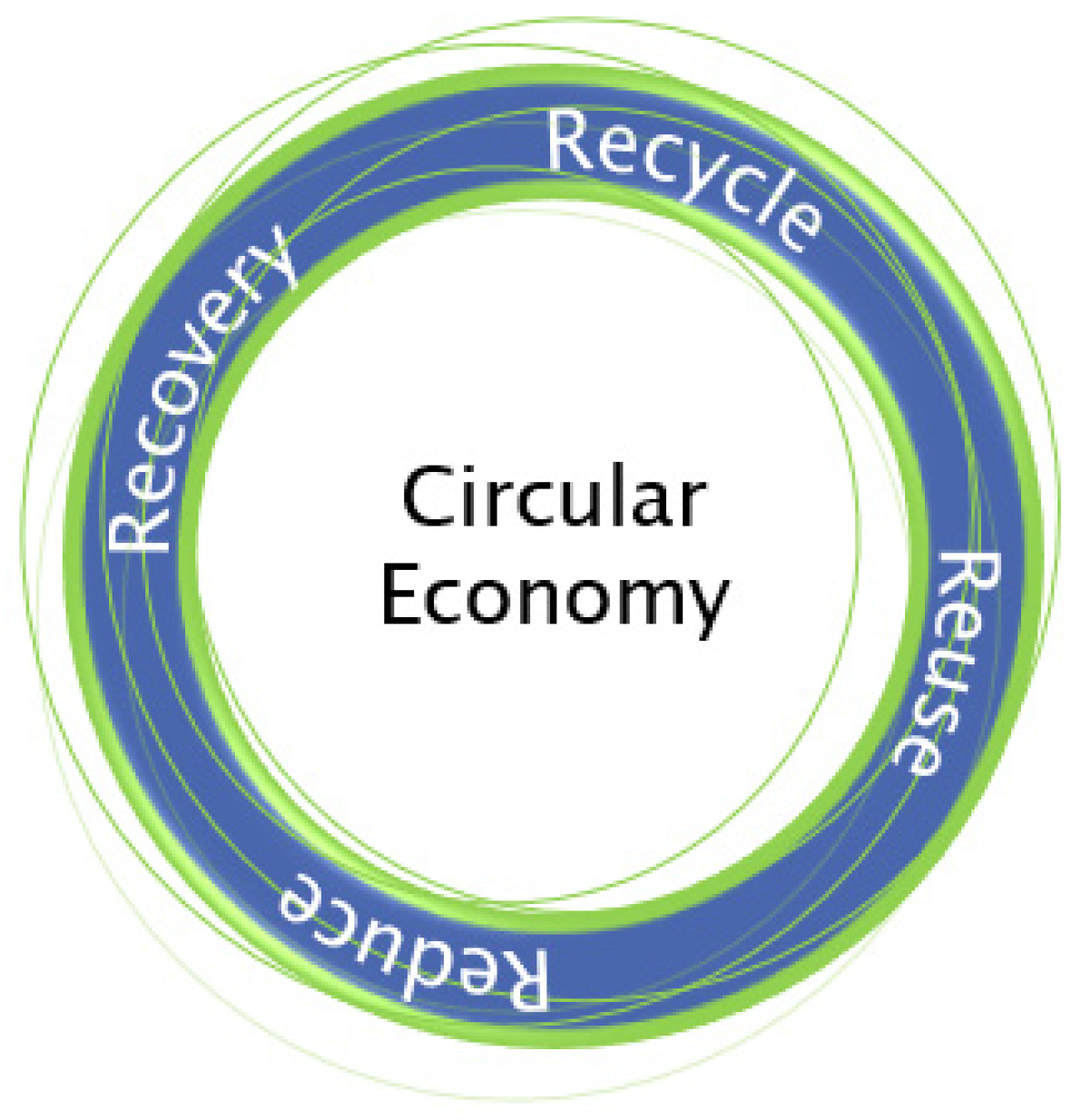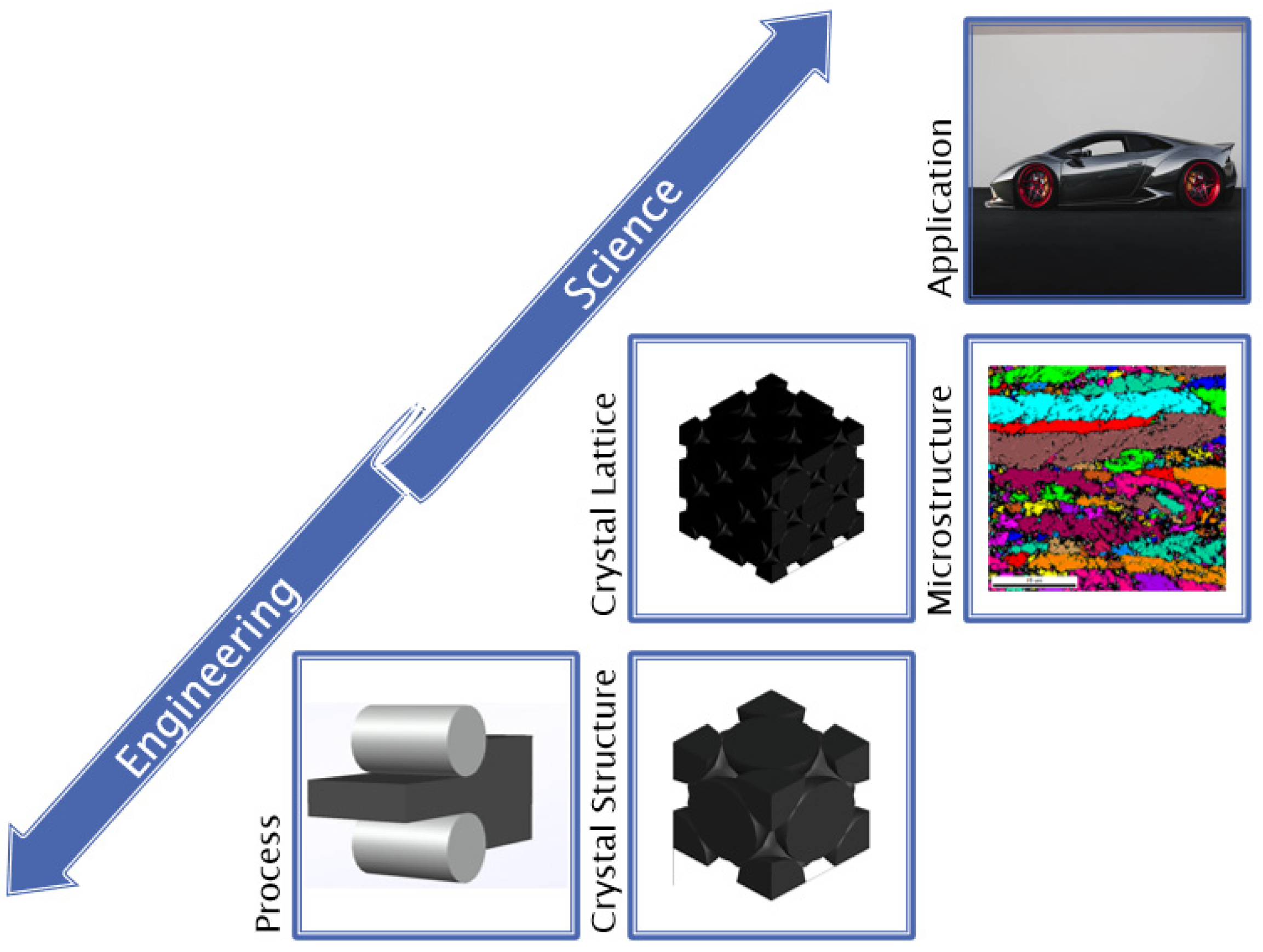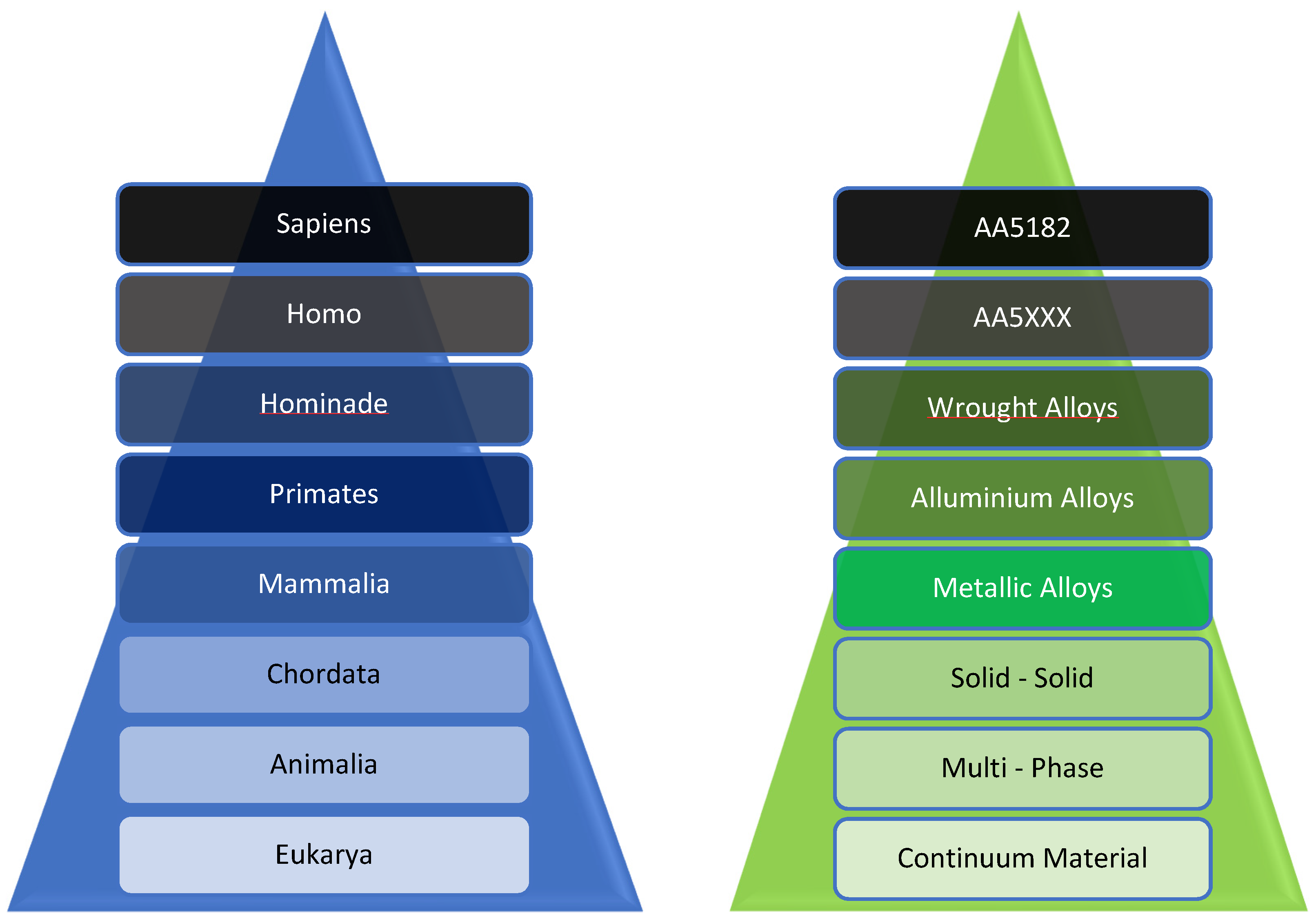1. Introduction
In the last three centuries, we have witnessed three major industrial revolutions 1765, 1870 and 1969 [
1]. Each one of them almost a century apart. Now, about half a century from the last one, many experts believe that we are experiencing the fourth one. The industry 4.0 or the Internet of Things (IoT) and Artificial Intelligence (AI).
Digital Twins fall under the big data and AI categories and are programs that simulate the production line of a factory and how each one of the parameters will affect the final properties of the product and the overall efficiency of the facility. On the other hand, according to the Integrated Computational Material Engineering (ICME) approach, detailed simulations of processes and materials enhance the output of the materials design, reduce the cost, accelerate the process/materials development time and couple manufacturing processes at various scale levels providing insights on how various parameter changes affect the microstructure–properties relationships of advanced materials.
The implementation of the new tools and new technologies are very promising in terms of a cost-effective production line as well as environmental friendliness. Both of them stem from the fact that this type of technology can improve the error margins in the selection of production parameters. An example is the temperature and stress distribution during rolling. By maximizing the properties of the final product, in the least possible amount of time, while minimizing the part of the production that is deemed as defective (home scrap), the result will be a cost and a time effective alternative. This branch of computer implementation is also known as computer-aided process planning (CAPP) and it includes Artificial Intelligence (AI), Integrated Computational Materials Engineering (ICME) as well as industrial twins (IT) and the occasional coupling of these methods. There are plentiful examples of research papers that are focused on the implementation of the foresaid methods in metal forming, welding and their defects (indicative work [
2,
3,
4,
5,
6,
7]) dating as far back as the late 20th century, foreshadowing what was to come. Circular economy is commonly known by its 4Rs (recovery, recycle, reduce, reuse) (
Figure 1). ICME and AI technologies have the potential to assist with “Reduce” through the error margins as stated above.
ICME is a discipline composed of various mathematical models (phase field, crystal plasticity, CALPHAD, etc.), which are combined in order to develop materials and processes. The concept of ICME was first coined in the USA, in 2005, as a response to the industrial need to develop durable components by minimizing cost within a short time frame. This methodology has the potential to accelerate the development of new materials [
8]. The core of the ICME approach is to exploit the microstructure–properties relationship by investigating how the thermal history of a material affects its response to processing and how the processing affects the final properties of the material. In its full form, ICME involves the integration of information regarding process, design and material at different lengths and time scales within a holistic system [
8,
9]. The ICME discipline is applied in the field of materials technology, mechanical engineering, metallurgical engineering, information technology and numerical and mathematical science. The required input is drawn from thermodynamical databases and is adapted to the specific workflow of each situation.
Figure 2 shows the correlation between the process parameters and the final application of the material. Engineering tries to perfect the process in order to achieve the desired properties for the application whereas, the science tries to implement the existing procedures for new applications.
The tools used in this type of modeling have made significant progress in the last few years and are able to calculate a number of “variables” as phase fraction, precipitation, transus temperatures, material properties, diffusion and microstructure, whereas they are still unable to perform inverse modeling. From an industrial point of view, the ICME approach offers solutions to real problems in ongoing production processes. It can be utilized in the development of new products, optimization of current processes and understanding the phenomena occurring during the production process in the material. The major advantage of ICME is that it reduces designing effort in terms of cost and time since the classical approach of trial and error is avoided. In this way, waste material is reduced, and the financial risks are minimized.
The major challenge of this approach is that a complete modeling description must be created corresponding to the manufacturing process, the material’s properties and the performance in service. In order to meet this demand, a global platform must be created in which different models describing the material’s properties and production process will be incorporated allowing the information exchange. Initiatives from all over the world have emerged offering integration solutions such as COMSOL Multiphysics, NanoSim, MoDeNa, Kratos, Computational Materials Design Facility (CMDF), AixVipMap, etc. [
10]. The ICME approach can be exploited for the simulation of the thermomechanical control process in the steel industry. During thermomechanical control processing, various metallurgical phenomena, such as static and dynamic recrystallization, grain growth and austenite to ferrite transformation, take place affecting the final microstructure. The force exerted from the pressure rolls not only deforms the width of the plate, but also introduces dislocations in the microstructure and alters the stored energy in the microstructure, which is the driving force for the recrystallization. Therefore, simulation of thermomechanical processing, coupled with simulation of microstructural evolution, would not only aid understanding of the phenomena that take place, but also optimize the thermomechanical process in order to control the microstructure evolution and, subsequently, the mechanical properties. A similar example would be the application of the ICME approach in the hot extrusion process of 6xxx aluminum series. Similar to the thermomechanical control process of steels, 6xxx aluminum alloys undergo alterations in the microstructure due to the simultaneous recrystallization and precipitation phenomena. Both of which have significant effects on grain size and dislocation pinning, thus, on the mechanical properties. This opinion article aims to highlight the current state and trends of the industry, as well as analyze the opportunities that are still untapped.
2. AI
Artificial Intelligence is the discipline of computer science that is focused in enabling the computer to perform certain intellectual/intelligent tasks [
11]. The computer code is written in such a way that it performs a correlation between various parameters and the end results. Each one of these parameters is assigned a weight factor depending on the degree that it affects the process. These correlations occur through “feeding” the algorithm with large amounts of data, in the order of a few thousand, called a training set. An example of this, in the context of Artificial Neural Networks, is shown in
Figure 3, where its node represents a different calculation.
The term AI today usually refers to narrow AI. This is defined as the type of AI that is capable of performing one very specialized task, such as identifying surface defects, with some degree of intelligence. A subset of that is known as machine learning (M.L.), in which the machine is solving a specific problem, predicts an outcome, etc., without being specifically programmed to do so [
12] and it is the part of AI that the present work is mainly focused on.
The most important part of an M.L. algorithm is the loss function, which calculates the difference between the real, measured values and those predicted by the computer (like the least squares method).
The next paragraphs highlight the key points of AI in order to allow for some initial conclusions.
Taxonomy is the process in which various objects are classified [
13]. An example of that is the AA5182 which is compared to the taxonomy of the human species in
Figure 4. Each “step” in this pyramid is characterized by certain attributes (e.g., chemical composition or hardening mechanisms).
By the term ontology, we are referring to a more complex version/subset of taxonomy, which is enriched with information and relations between the attributes/properties. For example, metallic alloys are conductive, whereas ceramics are not. Thus the “step” metallic alloys are connected with the properties of thermal and electrical conductivity, and the solid is connected with properties such as melting point and so on.
These are process/connections that humans make almost instinctively, but the computer must be programmed to be able to perform. Via the taxonomy routines, the computer can give specific attributes to the “input” while eliminating some others. An example of that is that aluminum alloy 5182 is a metal and, thus, is considered as an electric conductor whereas ceramics are not. Thus, by connecting the subset aluminum with the properties of metals, conductivity is attributed to it. Moreover since it is aluminum it is characterized by an FCC crystal structure, etc. Each property is then stored in a virtual node. These nodes are also known as artificial neurons (A.N.). The purpose of a neural network (N.N.) is to create the desirable connections between the A.N. so that new information can be correctly categorized and only calculate the required properties/parameters each time, thus reducing the computational cost [
14,
15].
Another type of AI is automated reasoning. This is referring to the sub field of AI where the computer is taught how to use deductive logic and implement that towards a specific goal such as checking calculations [
16].
Lastly, there are the theory-trained deep neural networks. This subset of AI differentiates from M.L. since the user inputs mathematical expressions into the computer, e.g., the Gibbs energy, phase/system enthalpy, which the computer solves for given boundary conditions. Their clear advantage over M.L. is that they do not need large volumes of data as input, but the mathematical background for many of the processes is currently lacking.
Existing studies including AI show the advantages it holds, mostly with regard to the computational cost [
11,
12]. However, a large amount of data is required as a training set. That makes the usage of neural networks counterproductive if the user is switching between different types of projects. Nowadays in the manufacturing industry, the process parameters are meticulously recorded, but the data produced are still not exploited. A possible application of M.L. in the metal sector is to assess data from casting in order to select the optimum casting temperature and superheat. Similarly, it can be utilized in the homogenization of alloys in order to select the optimum homogenization temperature depending on each alloy. Finally, M.L. can be used to exploit the scrap of a factory to the fullest potential. Having a record of the alloys contained in a scrap yard and the alloys that can be produced from the scrap, M.L. can be incorporated in order to select the right proportions of each alloy so as to achieve the chemical composition of the target alloys. This paradigm indicates how an industrial facility could optimize the recycling process with the aid of AI and in this way comply with legislation rules.
3. Summary
So far there has been a lot of progress in the field of ICME. The modeling methods have been improving geometrically with regard to both the application spectrum and the result accuracy. Currently, using modeling techniques to predict the behavior of various systems with low operating costs and then, verifying their results with physical models is considered to be the “best practice available”. Artificial Intelligence is a relatively new field that has not been applied yet to the full extent of its capabilities. The error margins are, for the time being, larger and most people are unfamiliar with how these technologies can be used. However, despite their vast differences, both methodologies can be applied to model and then simulate how the parameters of a single, targeted, process affect the properties of its (semi) final product. On the other hand, the industrial digital twin is used to simulate how every change at any of the stages would affect the whole, downstream, manufacturing process. That means that a much greater number of calculations are needed and, thus, the computational cost of such approach is extremely high to be realistic, since it would require more time to test different scenarios, making it very close to the original position of physically testing every hypothesis. Therefore, a hybrid model consisting of a targeted approach to optimize a certain procedure and afterwards, if needed, a digital twin model could be applied for certain changes followed by physical validation, is considered to be the best solution.
In the future, where quantum computers would be widely available, and the hardware of the computer will be neuromorphic, processing times would be practically eliminated allowing for more complex and “complete” calculations.











